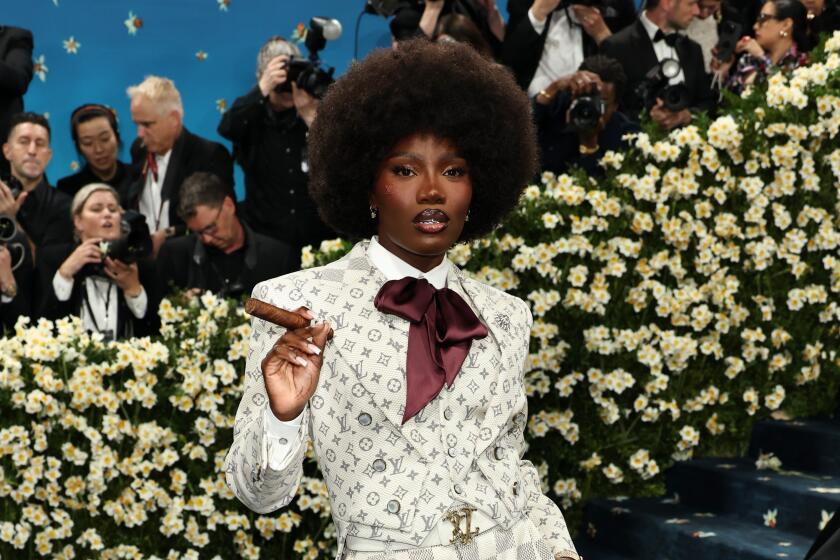Laying to rest the morbid view of mortuaries : Museum offers a lively look at American funerals, complete with virtual parade of custom hearses.
- Share via
HOUSTON — Think, dear friends, of death.
Ponder, for a moment, the stereotype of the undertaker: a dark-suited, pallid man with hands clasped, offering condolences to the bereaved while at the same time trying to sell them a casket they can’t afford.
Not fair, say aggrieved members of the funeral profession. Not fair at all. Funeral directors, they contend, are business people who also perform a valuable public service in trying circumstances.
The flip side of the coffin, as it were, now comes from Robert Waltrip, the chairman of Service Corporation International, who last month opened the 20,000-square-foot American Funeral Home Museum--a tribute to those who lay others to rest.
The name of Waltrip’s rather bland-sounding company belies the fact that it is the reigning funeral giant of the world, operating 670 funeral homes and 139 cemeteries throughout the United States and Canada.
Waltrip, who comes from a family of funeral home owners, has long dreamed of a funeral home museum and ponied up $1 million of SCI money to get the project started.
Now, a funeral home museum may seem like something of a reach. But the fact is, there’s a museum out there for almost everything.
Consider that there is a nut (as in walnut, peanut, etc.) museum in Connecticut and a national taxidermy hall of fame in Pennsylvania, a Tupperware museum in Florida and a whiskey history museum in Kentucky. There is even an ancient brick museum in Tennessee, not to mention the roller-skating museum in Nebraska.
The funeral home museum, adjacent to an apartment complex in the outer reaches of northern Houston, is housed in a new, though somewhat nondescript, brick building that also contains a mortuary college and continuing education facility for morticians.
The primary color inside the museum, of course, is black. The giant room is filled with gleaming antique hearses, some motorized, others from the horse-drawn era, but almost all of them a gleaming ebony. One of the most dramatic is a 1921 Rockfalls hearse, whose builders used six types of wood to make the hand-carved body.
But the one with the best story is the 1916 Packard funeral bus, built to carry coffin, flowers, pallbearers and mourners, rather than stringing them out in a line of traffic. The one on display was being used in San Francisco when it tipped upward while climbing a steep hill because of too much weight in the rear.
In one of those worst possible kinds of scenes, the casket tipped over and so did the flowers. The pallbearers tumbled into the mourners.
The bus was immediately retired from the funeral business and became the home for a California ranch hand for the next 40 years before being retrieved, restored and eventually donated to the museum by Clarkston, Wash., funeral home owner Robert Larrabee.
“It’s a piece of history,” Larrabee said. “It’s the only survivor that we know about.”
The people associated with the museum are definitely upbeat about this celebration of the funeral business.
“People are fearful about things they are not educated about,” said Julie Nelson, the museum coordinator. “This is an opportunity to educate and enlighten people about something that is viewed as depressing and having a dark side.”
Perhaps so. But a walk through the museum is hardly a cheery romp.
First comes the film about the funeral business, which explains that early undertakers often did the work as a sideline to a cabinetmaking or livery business.
Next to that are newspaper clippings and displays about the famous who have died, from John F. Kennedy to Elvis Presley to Will Rogers to Helena Rubenstein. (Southern California is well represented here, with front pages from several newspapers, including The Times.)
Farther along is the famous triple casket, ordered by a grieving couple whose small child had died. Their plan was to commit a double suicide and have the whole family buried in the same coffin. The couple eventually changed their minds, but by then the casket had been built.
Then there is the re-creation of a 1920s embalming room, complete with a black leather cooling board and a number of chrome embalming machines. Off to the side are the wicker baskets used to take the deceased from their homes to the funeral parlor.
Finally there are caskets from the past, including cast-iron models from the mid-18th Century, which had windows on them so the living could see the dead. It was the casket of choice during the Civil War.
Chris Layton, who also works at the museum, said funeral home directors from around the country combed through their attics and old files looking for items to contribute. He said there was a warehouse full of things not on display and that the donations were so numerous because funeral directors tend to be pack rats.
“Funeral directors keep things forever,” he said.
More to Read
The biggest entertainment stories
Get our big stories about Hollywood, film, television, music, arts, culture and more right in your inbox as soon as they publish.
You may occasionally receive promotional content from the Los Angeles Times.










